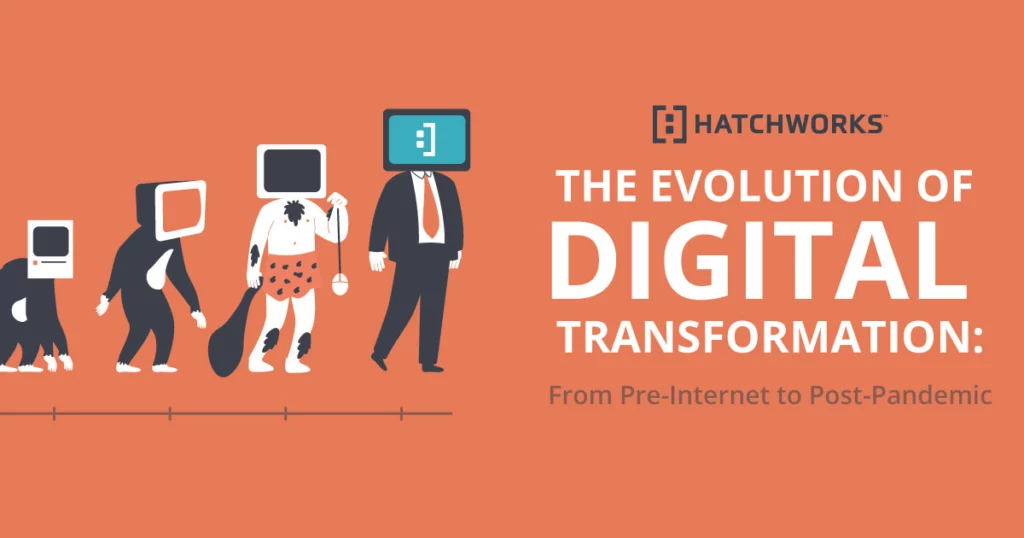Digital Transformation has an interesting history before becoming one of the most talked about buzzwords in the business world today.
You likely have heard it mentioned in your CEO’s strategic initiatives. However, what once seemed like lip service for stakeholders and investors has now become increasingly important and a critical part of staying competitive in today’s market.

Spending on digital transformation reached a staggering $1.6 trillion in 2022 and is projected to reach $3.4 trillion in 2026.
That is some serious investment.
But where did the idea of digital transformation come from? Let’s first define what it is.
In this article, we cover:
What is digital transformation?
Digital transformation refers to the use of digital technologies to modify or create new business processes, customer experiences, and organizational culture in response to changes in the market, customer insights, and business needs.
Integral to this process are digital solutions, which are essential in modernizing existing business models or creating new ones, thereby transforming businesses into digital-first organizations that leverage these solutions for internal operations, customer engagement, product digitization, and enterprise infrastructure support.
In some cases, this can lead to complete shifts in business models creating seismic waves throughout an organization.
Now that we have a better understanding of what digital transformation is, let’s look at its history and how it has evolved over time.
The History of Digital Transformation
Integrating Digital Technology into Business Processes Through the Ages
There are five distinct eras in the evolution of digital transformation that have forced companies to adapt how they operate and serve their customers.
Those who have been unable to adapt typically go the way of the dodo bird.
Pre-internet Era
1950 – 1989
This is where the foundational building blocks of the digital revolution and digital transformation were created. The invention of microchips and semiconductors enabled manual processes to be converted into digital technologies.

This started the first major digital transformation. Companies focused on shifting outdated processes to digital data. Worldwide, this created a need for business transformation and cultural change.
- 1958 The microchip and semiconductor were invented
- 1960 Moore’s Law defined
Post-internet Era
1990 – 2006
The next digital era created massive change and new digital technology. The internet started the shift from a siloed world into a global one.
Connection, data sharing, and access to public data through the internet created a more ubiquitous playing field.
Personal computers exploded during this era, giving people terminals to the World Wide Web in their living rooms, and the first social networks began to crop up.

- 1990 Internet becomes publicly available
- 1998 Google founded
- 2000 Half of US households have a personal computer
- 2004 Facebook founded
- 2005 Internet users reach $1 billion worldwide
- 2006 AWS created
Mobile Era
2007 – 2019
Just when companies were becoming comfortable with the modern internet and its impact on their business, another foundation shift happened with the introduction of the iPhone and the shift to mobile.

This opened up a world of possibilities, new business models, and the introduction of new social and mobile channels, which drove another spike in digital transformation.
Marc Andreesen‘s seminal writing, “Why Software is Eating the World”, laid out a clear vision of the future where software would disrupt every industry across the globe, and how new software-centric players would have the upper hand in this new world.
Interestingly enough, this is also around the time when the term “Digital Transformation” was first coined. Now the cycle of change required to stay competitive had a name.
- 2007 iPhone released giving rise to the mobile revolution
- 2011 “Why Software is Eating the World” written
- 2013 The term “Digital Transformation” is coined
Post-Pandemic Era
2020 – 2022
The last major era was the post-pandemic era. The pandemic accelerated digital innovations as companies were forced to rethink how they served their customers in a non-contact and remote world.

- 2020 Global Pandemic
- 2022 Digital Transformation spending at $1.6 trillion
Generative AI Era
2022 – Present
The era we are currently in right now is the era of Generative Artificial Intelligence or Gen AI. The pandemic accelerated digital innovations as companies were forced to rethink how they served their customers in a non-contact and remote world.
Additionally, the banking sector has been quick to adopt new digital technologies such as AI-driven chatbots and advanced fraud detection systems to enhance customer service delivery and security, forming new digital pathways between customers and the business.
New technologies and advances in AI and machine learning are playing a huge and critical role in digital transformation initiatives.
While the history of AI warrants its own timeline, advances in machine learning and tools like ChatGPT are clearly going to drive even more change in the way we work, interact, and live.

This ushered in shifts in business models and forced companies to take their digital transformation initiatives from the board room to the front lines with new urgency. This acceleration was the push many companies needed to implement a better customer experience.
- November 2022 OpenAI launches ChatGPT, a groundbreaking generative AI chatbot, marking a significant advancement in natural language processing and generative AI capabilities.
- December 2022 ChatGPT reaches 1 million users in just 5 days after launch, setting a record for the fastest-growing consumer application.
- 2023 Generative AI becomes a central focus across industries, influencing a wide range of applications from content creation to business analytics. This year also sees a surge in regulatory discussions and ethical considerations around AI, reflecting its growing influence and the need for frameworks to ensure responsible use.
- March 2023 Meta’s LLaMA (Large Language Model Meta AI) model is leaked, sparking debates around open-source AI development.
- April 2023 Amazon announces Bedrock, its large language model for code generation and understanding.
- May 2023 OpenAI launches an iOS app for ChatGPT, supporting chat history syncing and voice input.
- November 2023 OpenAI hosts its first-ever developer day, announcing custom GPT models tailored for specific use cases.
- December 2023 Midjourney, the AI-powered image generation tool, gains significant traction and popularity.
- December 2023 Google introduced Gemini, its largest and most capable AI model to date.
- 2024 Predicted to be a year of maturity for generative AI, with advancements expected to solidify its role in enhancing productivity and innovation across sectors.
- February 2024 OpenAI releases Sora, an AI assistant focused on open-ended dialogue and task completion.
- April 2024 Meta launches LLaMA 3, its advanced open-source large language model
How to approach digital technologies
Each digital era has prompted businesses to reconsider their internal operations and customer expectations, creating opportunities for new market entrants and transforming, or even retiring, existing business models.
The key mistake many businesses make is treating digital transformation as a finite task that can be completed. Instead, it should be viewed as a continuous process of evolution and improvement, necessitating the formulation of digital transformation strategies to guide the successful implementation of digital transformation projects.
A comprehensive digital transformation strategy is crucial for aligning technology investments with business goals, ensuring that efforts in digitization and innovation lead to sustainable growth and competitiveness as businesses operate in the evolving digital world.
Navigating digital transformation effectively remains a challenging task. It involves overhauling legacy processes and systems, which is a substantial undertaking requiring both courage and resilience.
At HatchWorks, we have embraced Generative AI to revolutionize this process through what we call Generative-Driven Development™ (GenDD). This approach harnesses the power of generative AI to enhance various stages of the software development lifecycle, from initial design to final testing and deployment.
This integration of AI allows for more agile development processes, faster turnaround times, and enhanced innovation, ensuring that new systems not only meet current needs but are also adaptable for future customer demands too.
Furthermore, we offer specialized AI-Powered Software Development services, designed to integrate AI capabilities into product development. This service aims to streamline production cycles, enhance product functionality, increase efficiency, and deliver superior user experiences by leveraging the latest advancements in AI technology.
By incorporating these methodologies, HatchWorks not only stays at the forefront of technological innovation but also provides its clients with cutting-edge solutions that are efficient, effective, and ahead of the curve.
🔷 For more details on our approaches, visit Generative-Driven Development™ and AI-Powered Software Development.
Frequently Asked Questions about Digital Transformation
Some key events in the history of digital transformation include the rise of the internet, the emergence of social media, the development of mobile technology, and the growth of cloud computing and big data analytics.
All industries have been impacted by digital transformation to some degree, but some of the most significant changes have occurred in the retail, financial services, media, and entertainment industries.
Digital transformation has had a profound impact on society, enabling people to connect, communicate, and collaborate in ways that were previously unimaginable. It has also changed the way we access information, shop, and consume media.
The future of digital transformation is difficult to predict with certainty, but it is likely to involve continued advancements in artificial intelligence, the Internet of Things, and other emerging technologies. It will also involve the ongoing integration of digital technology into all aspects of business and society.
Organizations can benefit from digital transformation in many ways, including improved efficiency and productivity, enhanced customer experiences, greater agility and competitiveness, and more growth opportunities, and the ability to generate new revenue streams and business models.
Organizations may face a number of challenges when undergoing digital transformation, including the need to update legacy systems, the complexity of integrating new technologies with legacy technology, and the potential for disruption to existing processes and organizational culture.
Digital transformation has changed the way we work in many ways, including the ability to work remotely, the use of digital tools and platforms for collaboration and communication, and the rise of the gig economy and other flexible work arrangements.
Let’s Build Your AI Strategy
Meet with our AI experts to explore your goals and challenges.
We’ll work with you to create a tailored AI Strategy and Roadmap that turns AI into ROI.





